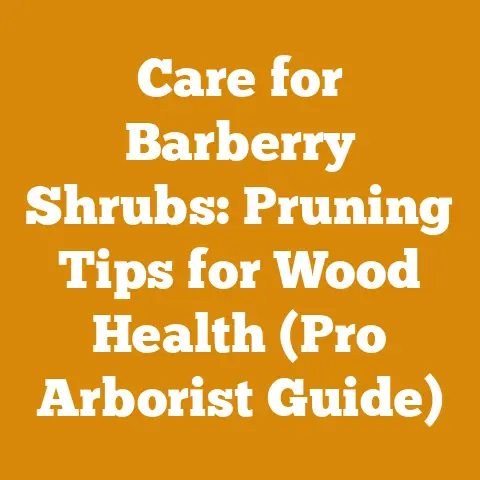Logger Hard Hat Safety (5 Must-Know Arborist Tips)
Introduction: Logger Hard Hat Safety (5 Must-Know Arborist Tips)
As a seasoned logger and arborist, I’ve spent countless hours in the woods, felling trees, processing timber, and preparing firewood. Sustainability is paramount in our line of work. It’s about ensuring the forests we rely on are healthy and productive for generations to come. This means responsible harvesting, replanting, and minimizing waste. I believe that every tree we take down should be replaced, and every piece of wood should be used efficiently.
One thing that has remained constant throughout my career is the absolute necessity of prioritizing safety. I’ve seen firsthand how a simple hard hat can prevent serious head injuries, and I want to share my experience and knowledge with you.
In this guide, I’ll be sharing five essential arborist tips for logger hard hat safety. These aren’t just theoretical guidelines; they’re practical lessons learned from years of working in the woods. My goal is to help you understand the importance of proper head protection and equip you with the knowledge to make informed decisions about your safety.
Understanding Hard Hat Standards and Classifications
Choosing the right hard hat is the first step in ensuring your safety. Not all hard hats are created equal. They are designed and tested to meet specific standards, and understanding these standards is crucial.
ANSI/ISEA Z89.1 Standard
- Impact Protection: Hard hats must be able to withstand impacts from falling objects.
- Penetration Resistance: Hard hats must resist penetration from sharp objects.
- Electrical Insulation: Some hard hats are designed to provide electrical insulation.
- Flame Resistance: Hard hats must be flame resistant.
Hard Hat Classifications: Class G, E, and C
Hard hats are classified into three types based on their electrical protection capabilities:
- Class G (General): These hard hats are designed to reduce the danger of impact and penetration, and they provide limited voltage protection (up to 2,200 volts). These are commonly used in general construction and manufacturing.
- Class E (Electrical): These hard hats offer the highest level of electrical protection, tested to withstand up to 20,000 volts. They also provide protection against impact and penetration. These are essential for workers dealing with high-voltage electricity.
- Class C (Conductive): These hard hats provide impact and penetration protection but offer no electrical protection. They are often made of aluminum or other conductive materials, making them unsuitable for work around electricity.
My Experience: I remember one time when I was working near a power line, and a tree branch fell, hitting my hard hat. I was wearing a Class E hard hat, and thankfully, it protected me from a potentially fatal electrical shock. That experience reinforced the importance of choosing the right class of hard hat for the job.
Understanding Type I and Type II Hard Hats
Beyond the class, hard hats are also categorized by type:
Takeaway: Understanding hard hat standards and classifications is crucial for choosing the right hard hat for your specific work environment. Always check the manufacturer’s label to ensure the hard hat meets the required standards and provides the necessary protection.
Inspecting Your Hard Hat: A Daily Ritual
A hard hat is only effective if it’s in good condition. Regular inspection is essential to identify any damage that could compromise its protective capabilities. I make it a habit to inspect my hard hat every day before starting work, and I encourage you to do the same.
Visual Inspection: Shell and Suspension
Start with a visual inspection of the hard hat shell. Look for any signs of cracks, dents, gouges, or discoloration. These could indicate that the hard hat has been subjected to impact or chemical exposure, which can weaken the material.
- Check the Shell: Examine the entire surface of the shell, both inside and out. Pay close attention to areas that may have been exposed to sunlight, as UV radiation can degrade the plastic over time.
- Inspect the Suspension System: The suspension system is the internal harness that holds the hard hat in place and absorbs impact energy. Check for any tears, fraying, or missing parts. Make sure the suspension system is properly attached to the shell.
Impact and Penetration Testing (Informal)
While you can’t perform formal impact and penetration tests in the field, you can do some informal checks to assess the hard hat’s condition.
- Flex Test: Gently flex the hard hat shell. It should feel firm and resilient. If it feels brittle or excessively flexible, it may be time to replace it.
- Sound Test: Tap the hard hat shell with a hard object, such as a wrench. A healthy hard hat will produce a clear, resonant sound. A dull or muffled sound could indicate internal damage.
Identifying Damage: Cracks, Dents, and Chemical Exposure
- Cracks: Even small cracks can significantly reduce the hard hat’s ability to withstand impact. If you find any cracks, retire the hard hat immediately.
- Dents: Dents indicate that the hard hat has been subjected to impact. If the dent is deep or covers a large area, replace the hard hat.
- Chemical Exposure: Exposure to certain chemicals can degrade the plastic in hard hats, making them brittle and weak. If your hard hat has been exposed to chemicals, consult the manufacturer’s recommendations for cleaning and inspection.
My Story: I once had a hard hat that looked perfectly fine on the outside, but after a close inspection, I noticed a small crack near the brim. It was barely visible, but I knew that it could compromise the hard hat’s integrity. I immediately replaced it. It’s better to be safe than sorry.
Tip: Keep a log of your hard hat inspections. This will help you track the condition of your hard hat and identify any trends or issues.
Takeaway: Regular inspection is crucial for identifying damage that could compromise your hard hat’s protective capabilities. Make it a daily ritual to inspect your hard hat before starting work.
Proper Fit and Adjustment: Ensuring Maximum Protection
A hard hat is only effective if it fits properly. A loose or improperly adjusted hard hat can slip off during an impact, leaving you vulnerable to injury. I’ve seen workers wearing hard hats that were too big or too small, and it’s a recipe for disaster.
Measuring Your Head Size
To ensure a proper fit, start by measuring your head circumference. Use a flexible measuring tape and wrap it around your head, just above your eyebrows and ears. This will give you your head size in inches or centimeters.
- Check the Manufacturer’s Size Chart: Consult the manufacturer’s size chart to determine the appropriate hard hat size for your head circumference.
Adjusting the Suspension System
The suspension system is the key to a comfortable and secure fit. Most hard hats have an adjustable suspension system that can be customized to fit your head size and shape.
- Adjust the Headband: The headband should fit snugly around your head without being too tight. Adjust the headband until it feels comfortable and secure.
- Adjust the Height: The height of the suspension system can also be adjusted to ensure that the hard hat sits properly on your head. The hard hat should sit level on your head, with the brim about an inch above your eyebrows.
Chin Straps: When and Why to Use Them
Chin straps are an essential part of a hard hat system, especially in situations where there is a risk of the hard hat falling off, such as when working at heights or in windy conditions.
- Secure the Chin Strap: The chin strap should be adjusted so that it fits snugly under your chin without being too tight. It should prevent the hard hat from falling off if you lean over or are subjected to a sudden movement.
- When to Use a Chin Strap: I always recommend using a chin strap when working in the woods. The terrain is uneven, and there’s always a risk of tripping or falling. A chin strap will keep your hard hat securely in place, even if you take a tumble.
My Experience: I once witnessed a logger who wasn’t wearing a chin strap trip and fall while carrying a log. His hard hat came off, and he hit his head on a rock. Fortunately, he wasn’t seriously injured, but it could have been much worse. That incident convinced me of the importance of always wearing a chin strap.
Tip: If you wear glasses, make sure they fit comfortably under your hard hat without interfering with the suspension system.
Takeaway: A properly fitted and adjusted hard hat is essential for maximum protection. Take the time to measure your head size, adjust the suspension system, and use a chin strap when necessary.
Hard Hat Lifespan and Replacement: Knowing When to Retire Your Helmet
Hard hats don’t last forever. Over time, exposure to sunlight, chemicals, and physical impacts can degrade the plastic and reduce its protective capabilities. Knowing when to retire your hard hat is crucial for maintaining your safety.
Manufacturer’s Recommendations
Most hard hat manufacturers provide recommendations for the lifespan of their products. These recommendations are based on laboratory testing and real-world experience. Always follow the manufacturer’s recommendations for hard hat replacement.
- Check the Expiration Date: Some hard hats have an expiration date printed on the shell. This date indicates the recommended service life of the hard hat.
- General Guidelines: As a general rule, hard hats should be replaced every five years, regardless of their condition. However, if the hard hat has been subjected to impact or chemical exposure, it should be replaced immediately.
Factors Affecting Hard Hat Lifespan
Several factors can affect the lifespan of a hard hat, including:
- Sunlight Exposure: UV radiation can degrade the plastic in hard hats, making them brittle and weak.
- Chemical Exposure: Exposure to certain chemicals can weaken the plastic and reduce its protective capabilities.
- Impact: Even minor impacts can damage the hard hat and reduce its ability to withstand future impacts.
- Storage: Improper storage can also affect the lifespan of a hard hat. Hard hats should be stored in a cool, dry place away from direct sunlight and chemicals.
Signs of Degradation: Cracking, Fading, and Brittleness
- Cracking: Even small cracks can significantly reduce the hard hat’s ability to withstand impact. If you find any cracks, retire the hard hat immediately.
- Fading: Fading or discoloration can indicate that the hard hat has been exposed to sunlight or chemicals.
- Brittleness: If the hard hat feels brittle or excessively flexible, it may be time to replace it.
My Rule of Thumb: I replace my hard hat every three years, regardless of its condition.
Tip: Keep a record of when you purchased your hard hat and when you should replace it. This will help you stay on top of your hard hat maintenance.
Takeaway: Hard hats have a limited lifespan and should be replaced regularly, even if they appear to be in good condition. Always follow the manufacturer’s recommendations and replace your hard hat immediately if it has been subjected to impact or chemical exposure.
Eye Protection: Safety Glasses and Face Shields
- Safety Glasses: Safety glasses are essential for protecting your eyes from flying debris, such as wood chips, sawdust, and branches. Choose safety glasses that meet the ANSI Z87.1 standard for impact resistance.
- Face Shields: Face shields provide additional protection for your face and eyes. They are especially useful when operating chainsaws or other power tools that can generate a lot of flying debris.
Hearing Protection: Earplugs and Earmuffs
- Earplugs: Earplugs are a simple and effective way to protect your hearing from the loud noise of chainsaws and other power tools. Choose earplugs that are properly fitted and have a high noise reduction rating (NRR).
- Earmuffs: Earmuffs provide a higher level of hearing protection than earplugs. They are also more comfortable to wear for extended periods.
Chainsaw Chaps: Protecting Your Legs
- Chainsaw Chaps: Chainsaw chaps are essential for protecting your legs from chainsaw cuts. They are made of a special material that is designed to stop the chainsaw chain and prevent serious injury.
- Proper Fit: Make sure your chainsaw chaps fit properly and cover your entire leg from the groin to the top of your boots.
Combining PPE for Optimal Protection
- Hard Hat Compatibility: When choosing PPE, make sure it is compatible with your hard hat. For example, some hard hats have slots for attaching earmuffs or face shields.
- Comfort and Mobility: Choose PPE that is comfortable to wear and allows you to move freely. If your PPE is uncomfortable, you’re less likely to wear it consistently.
My PPE Routine: When I’m working in the woods, I always wear a hard hat with a face shield and earmuffs, safety glasses, chainsaw chaps, and sturdy work boots. It may seem like a lot of gear, but it’s worth it to protect myself from injury.
Case Study: I remember a case where a logger was using a chainsaw to fell a tree. A branch kicked back and struck him in the face. He was wearing a hard hat with a face shield, which protected his eyes and face from serious injury. Without the face shield, he could have lost an eye.






